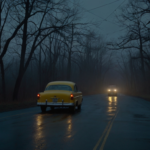Fear is a universal emotion, a primal instinct embedded deep within our psyche, designed to protect us from harm. Yet, paradoxically, many people actively seek out fear-inducing experiences. From horror movies to haunted attractions, the allure of being scared is undeniable. This fascination with fear is not just a modern phenomenon but has roots in ancient history. In this article, we will explore the psychology of fear, why people enjoy being scared, and the physiological responses that accompany fear. Through real-life examples and expert insights, we will delve into this intriguing aspect of human behavior.
The Evolutionary Roots of Fear
Fear is an evolutionary mechanism that has helped humans survive for millennia. When faced with a threat, the body’s “fight or flight” response is activated, preparing us to either confront or flee from danger. This response involves a cascade of physiological changes: adrenaline is released, heart rate and blood pressure increase, and blood flow is redirected to essential muscles.
Historically, these responses were critical for survival. Early humans needed to react swiftly to predators and other dangers. Fear triggered by the sight of a lurking predator or the sound of a dangerous animal in the bushes was essential for survival. Those who responded effectively to fear-inducing stimuli were more likely to survive and pass on their genes.
The Modern Context of Fear
In the modern world, the physical dangers that our ancestors faced are largely absent. Yet, the psychological mechanisms that trigger fear remain. This has led to a unique situation where people seek out fear in controlled environments. Horror movies, haunted houses, and thrill rides provide opportunities to experience fear without real danger.
The Appeal of Horror Movies
Horror movies are a quintessential example of how people indulge in fear for entertainment. The genre has evolved significantly, from classic films like “Psycho” and “The Exorcist” to contemporary hits like “Hereditary” and “Get Out.” These movies tap into various fears, from the supernatural to psychological horror.
Real-Life Example: “The Exorcist” (1973) “The Exorcist” is often cited as one of the scariest movies of all time. Upon its release, audiences were terrified, with reports of people fainting and vomiting in theaters. The movie’s depiction of demonic possession and the accompanying exorcism tapped into deep-seated fears of the unknown and the supernatural.
Psychological Explanation: Horror movies often exploit universal fears, such as fear of the dark, fear of death, and fear of the unknown. They create an immersive experience that allows viewers to confront these fears in a safe environment. This controlled exposure can lead to a cathartic experience, providing relief from anxiety and stress.
Physiological Responses to Fear
When watching a horror movie or experiencing a haunted attraction, the body undergoes several physiological changes. These responses are part of the “fight or flight” mechanism:
- Adrenaline Rush: The adrenal glands release adrenaline, increasing heart rate and blood pressure. This prepares the body for rapid action.
- Heightened Senses: Fear sharpens the senses. Pupils dilate to let in more light, and hearing becomes more acute.
- Increased Blood Flow: Blood is directed to major muscle groups, preparing the body for physical activity.
These physiological responses create a heightened state of arousal, making the experience more intense and memorable.
Psychological Theories Explaining the Appeal of Fear
Several psychological theories attempt to explain why people enjoy fear-inducing experiences:
- Excitation Transfer Theory: This theory suggests that the arousal caused by fear can enhance subsequent positive emotions. For example, after a scary movie, the relief and exhilaration felt can be more intense. This transfer of arousal can make fear-inducing experiences more enjoyable.Real-Life Example: Thrill Rides Roller coasters and other thrill rides are designed to induce fear. The sudden drops, high speeds, and unexpected turns trigger a strong fear response. However, the exhilaration felt at the end of the ride is amplified by the preceding fear, making the overall experience enjoyable.
- Catharsis Theory: According to this theory, experiencing fear in a controlled environment allows for the release of pent-up emotions. Watching horror movies or visiting haunted houses can provide a safe outlet for expressing fear and anxiety.Real-Life Example: Haunted Attractions Haunted houses and attractions are popular during Halloween. These experiences allow people to confront their fears in a fun and safe environment, providing a sense of relief and catharsis.
- Social and Cultural Influences: Social and cultural factors also play a significant role in the appeal of fear. Horror movies and haunted attractions are often group activities, fostering a sense of camaraderie and shared experience.Real-Life Example: Horror Movie Nights Watching horror movies with friends can enhance the experience. The shared fear and the collective reactions create a sense of bonding and make the experience more enjoyable.
The Role of Personality and Individual Differences
Not everyone enjoys fear-inducing experiences to the same extent. Individual differences in personality can influence how people respond to fear. Sensation-seeking and thrill-seeking individuals are more likely to enjoy horror movies and thrill rides.
- Sensation Seeking: Sensation seekers have a high need for novel and intense experiences. They are more likely to seek out horror movies and other fear-inducing activities.Real-Life Example: Extreme Sports Enthusiasts Individuals who engage in extreme sports like skydiving and bungee jumping often have high sensation-seeking tendencies. They enjoy the thrill and the adrenaline rush associated with these activities.
- Empathy and Fear Response: Empathy levels can also influence how people respond to horror. Highly empathetic individuals may find horror movies more distressing because they strongly identify with the characters’ fear and suffering.Real-Life Example: Emotional Reactions to Horror Movies People with high empathy may avoid certain horror movies or scenes that depict graphic violence or intense psychological distress, as these can evoke strong emotional responses.
The Therapeutic Potential of Fear
Interestingly, fear-inducing experiences can have therapeutic benefits. Exposure therapy, a psychological treatment for phobias and anxiety disorders, involves controlled exposure to fear-inducing stimuli. By gradually facing their fears in a safe environment, individuals can reduce their anxiety over time.
- Exposure Therapy: This therapeutic technique involves repeated exposure to the feared object or situation. Over time, the fear response diminishes, and the individual learns to cope with their anxiety.Real-Life Example: Treating Phobias A person with a fear of spiders (arachnophobia) might undergo exposure therapy, starting with looking at pictures of spiders and gradually progressing to being in the same room with a spider. This controlled exposure helps to reduce the fear response.
- Virtual Reality Therapy: Virtual reality (VR) technology is increasingly used in exposure therapy. VR allows for immersive and controlled fear-inducing experiences, making it a valuable tool for treating anxiety disorders and phobias.Real-Life Example: VR Therapy for PTSD Veterans with post-traumatic stress disorder (PTSD) have used VR therapy to confront and process traumatic experiences in a safe and controlled environment, helping to reduce symptoms of PTSD.
Cultural and Historical Perspectives on Fear
Fear has been a central theme in storytelling and entertainment for centuries. From ancient myths and legends to modern horror films, the fascination with fear is deeply rooted in human culture.
- Ancient Myths and Legends: Many ancient cultures have myths and legends that revolve around fear-inducing creatures and supernatural events. These stories served to explain the unknown and provide moral lessons.Real-Life Example: Greek Mythology Greek mythology is filled with fearsome creatures like Medusa, the Minotaur, and the Hydra. These myths were used to explain natural phenomena and teach moral lessons about bravery, hubris, and the consequences of defying the gods.
- The Gothic Tradition: The Gothic literary tradition, which emerged in the 18th century, is characterized by its emphasis on fear, horror, and the supernatural. Gothic novels like Mary Shelley’s “Frankenstein” and Bram Stoker’s “Dracula” have had a lasting impact on the horror genre.Real-Life Example: The Gothic Novel “Frankenstein,” written by Mary Shelley, explores themes of fear and the unknown through the story of Victor Frankenstein and his monstrous creation. The novel delves into the psychological and moral implications of playing God and the fear of the unknown consequences.
- Modern Horror and Cultural Reflection: Modern horror often reflects societal fears and anxieties. Films like “Night of the Living Dead” and “Get Out” address social issues such as racism, consumerism, and political instability, using horror as a lens to explore these themes.Real-Life Example: “Get Out” (2017) Jordan Peele’s “Get Out” uses horror to explore the theme of racism in contemporary society. The film’s depiction of the “Sunken Place” serves as a powerful metaphor for the marginalization and silencing of Black voices.
Conclusion: The Enduring Appeal of Fear
The psychology of fear is a complex and multifaceted topic, encompassing evolutionary biology, individual differences, cultural influences, and therapeutic applications. The reasons why people enjoy being scared are as varied as the fear-inducing experiences themselves. Whether through horror movies, haunted attractions, or thrill rides, the controlled experience of fear provides a safe and exhilarating way to confront our deepest anxieties and primal instincts.
Fear’s enduring appeal lies in its ability to evoke powerful emotions and create memorable experiences. It allows us to explore the darker aspects of human nature, confront our vulnerabilities, and emerge stronger and more resilient. In a world where real dangers are often abstract and distant, the thrill of fear offers a tangible and immediate connection to our primal selves.
As we continue to seek out fear in its many forms, we embrace a fundamental aspect of what it means to be human. The psychology of fear reveals not only our innate drive for survival but also our capacity for curiosity, exploration, and growth. Whether through the flickering lights of a horror movie screen or the dim corridors of a haunted house, the allure of fear will continue to captivate and challenge us, reminding us of the complex and fascinating nature of the human mind.


















































